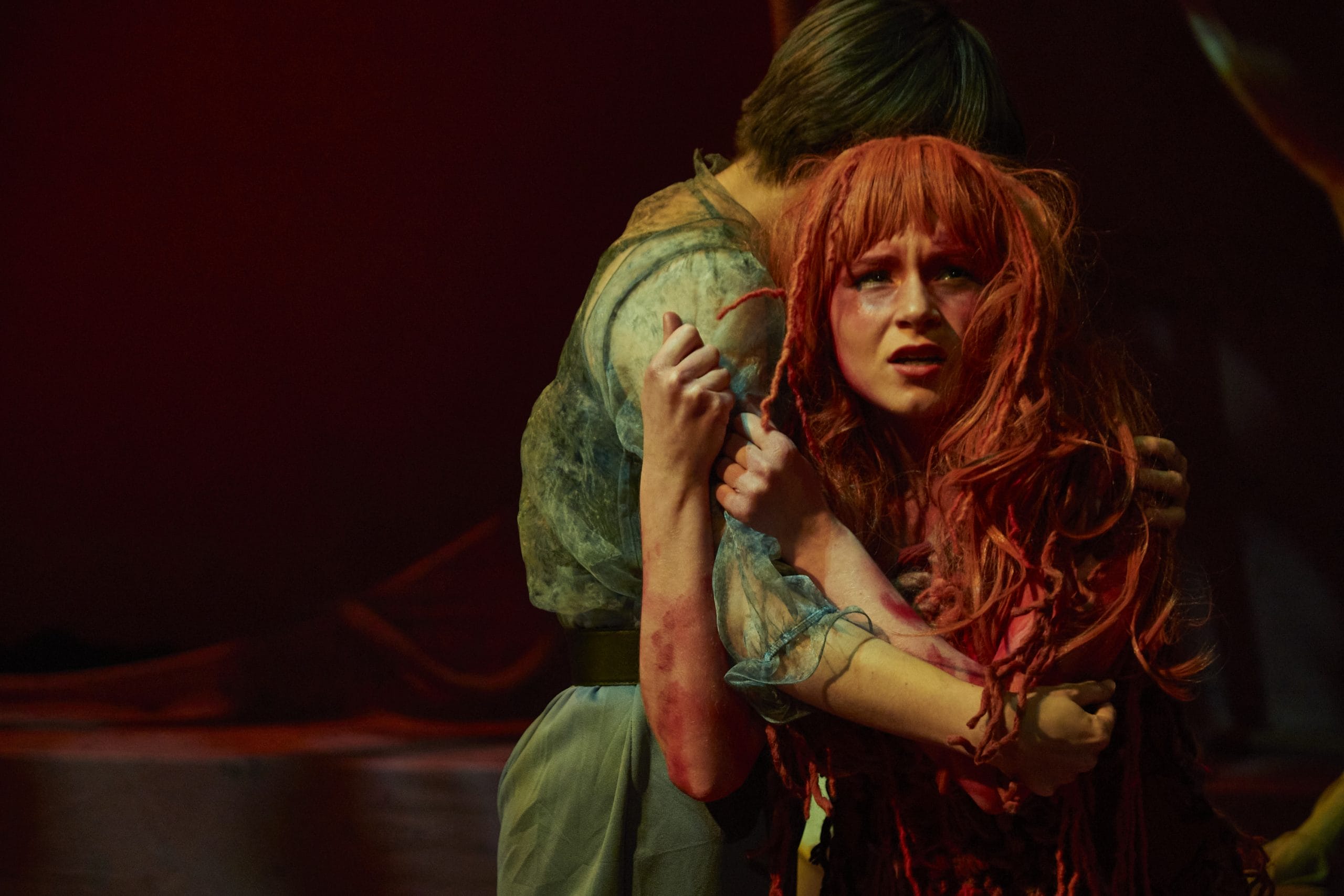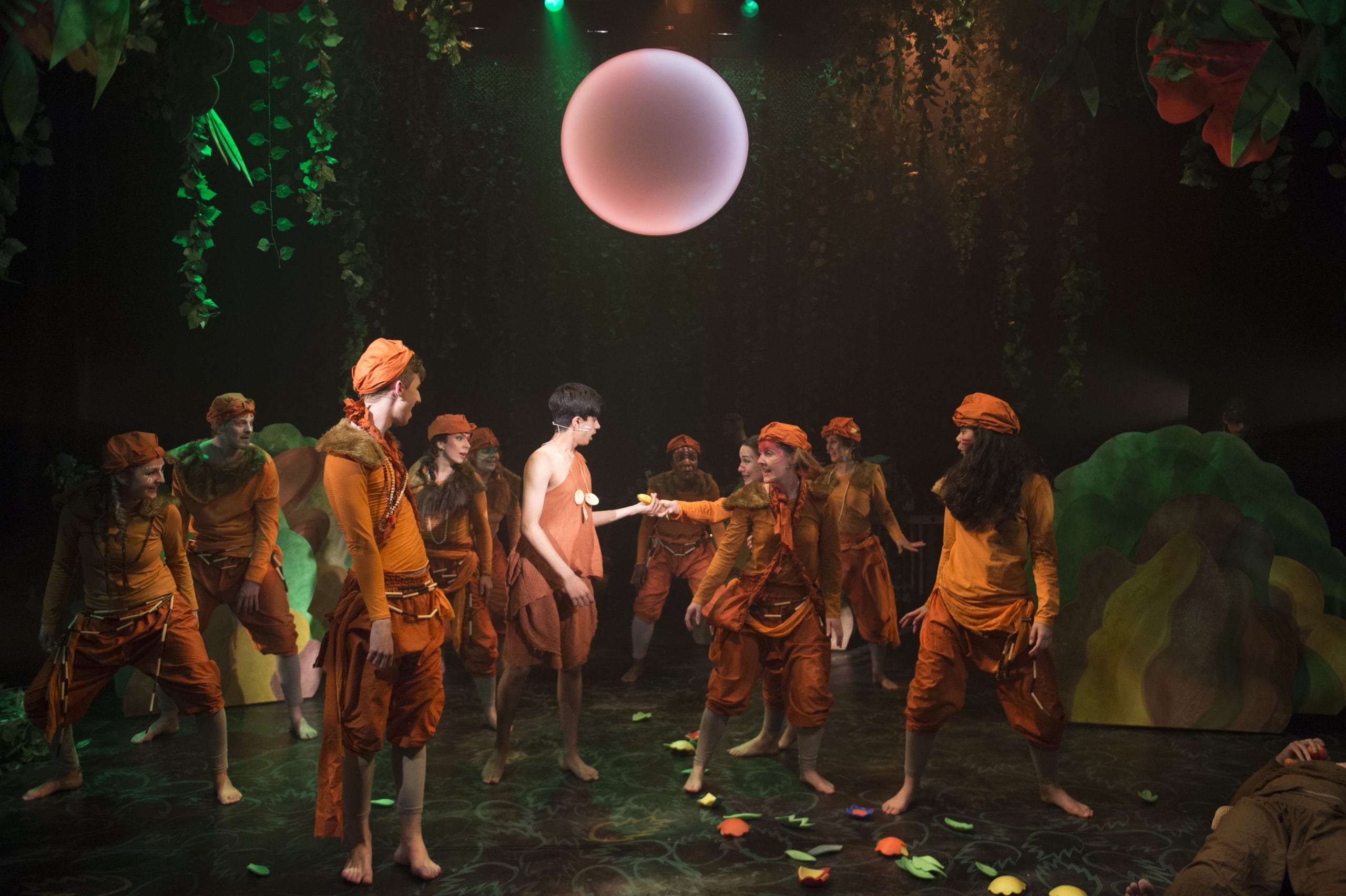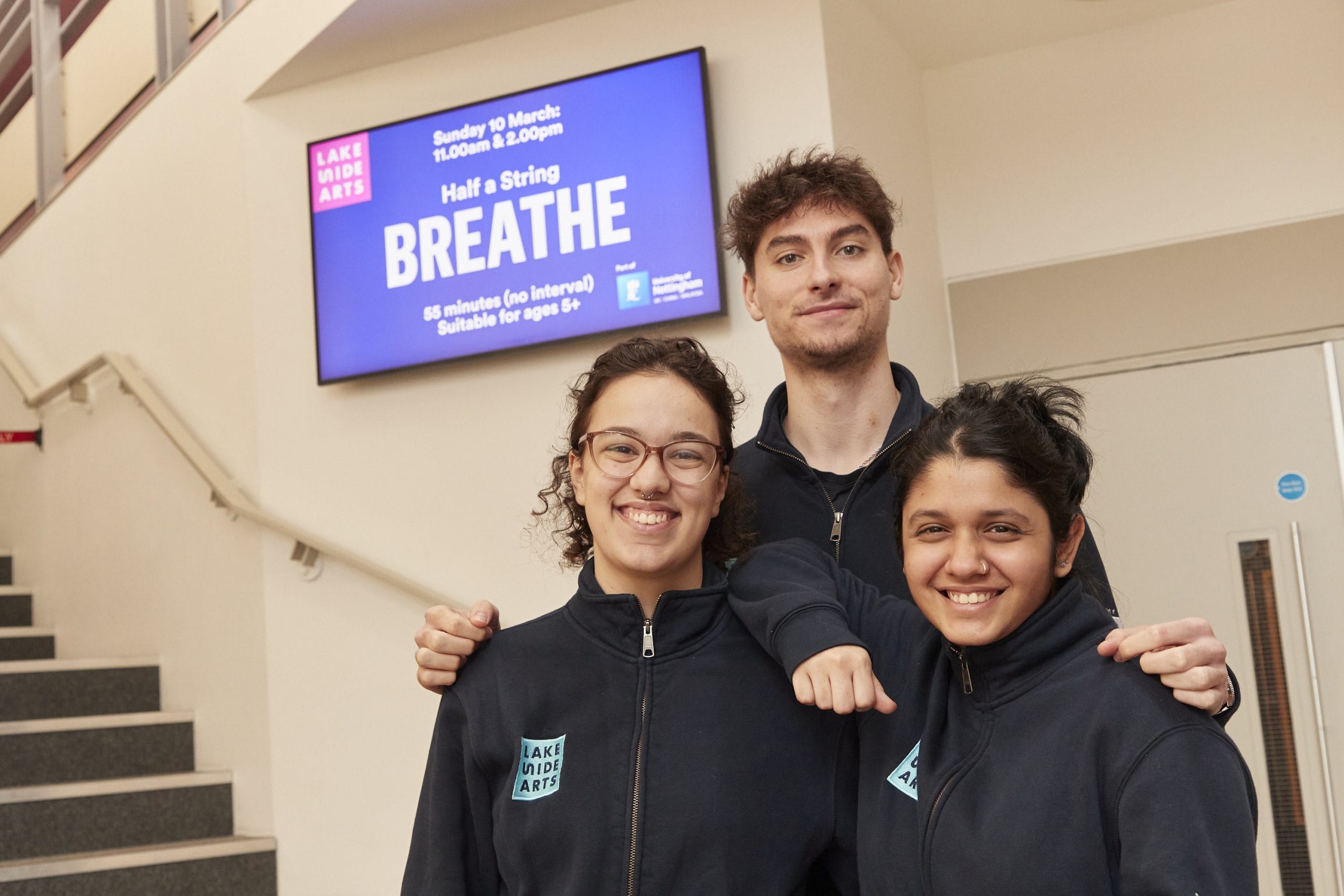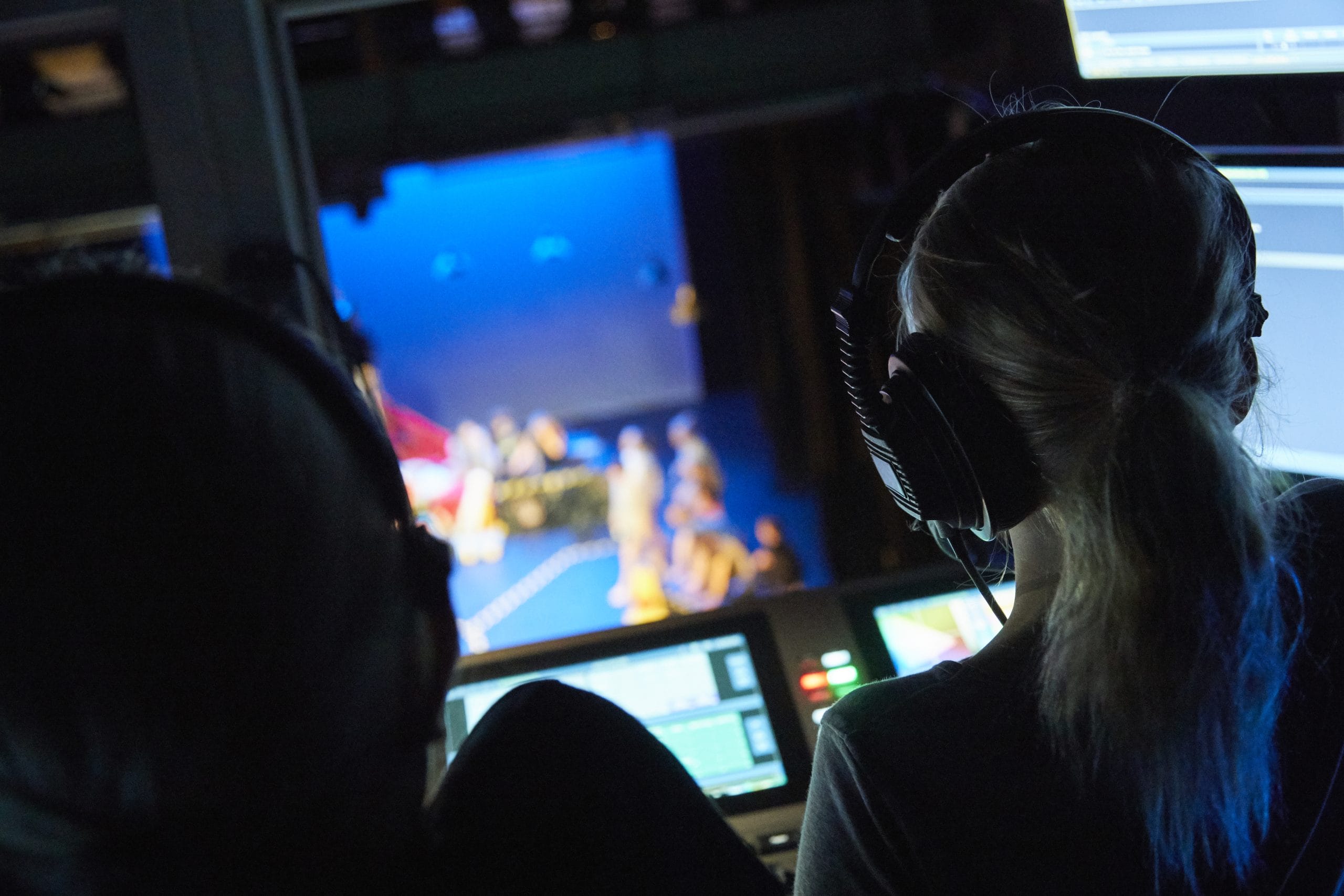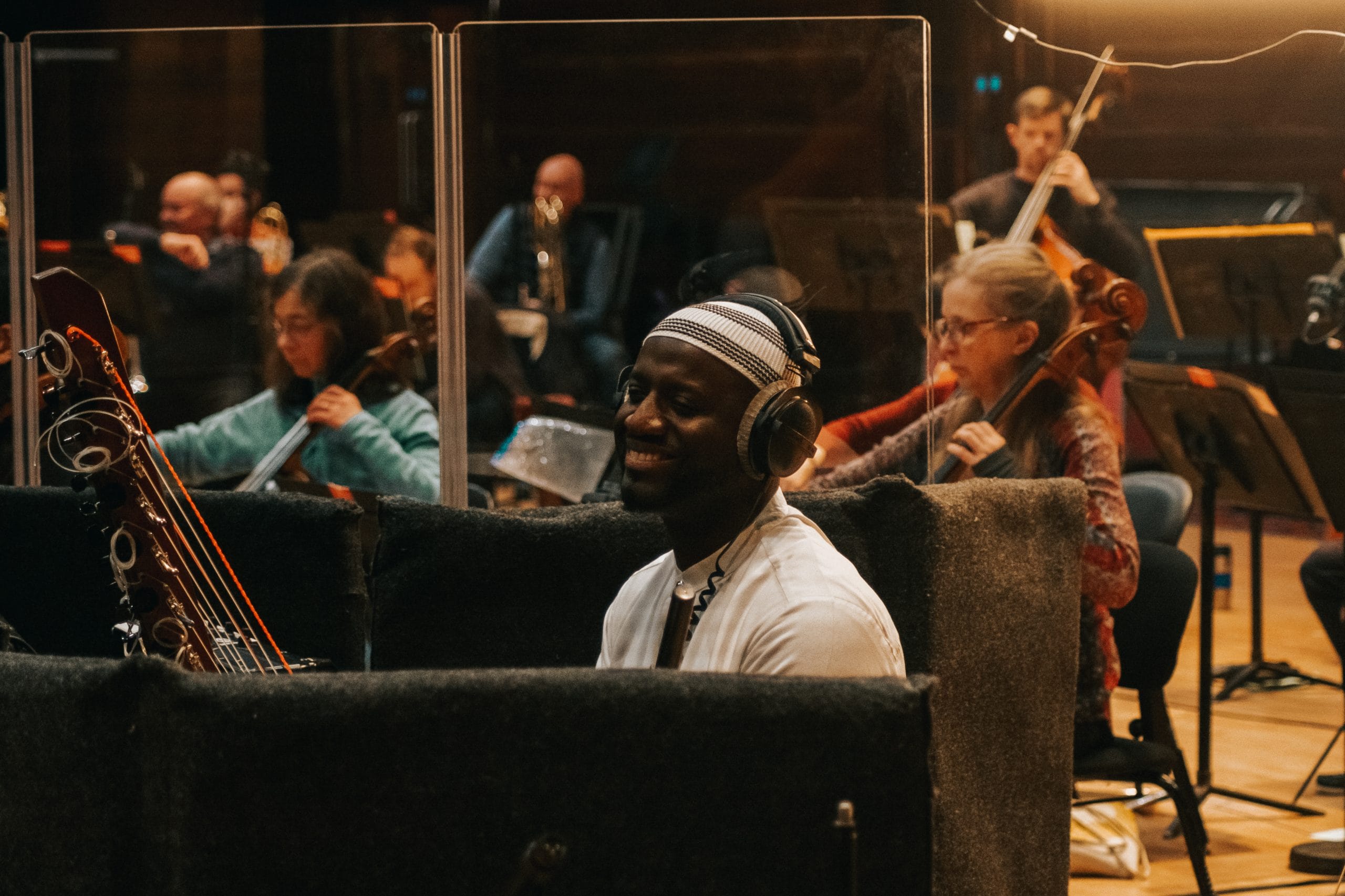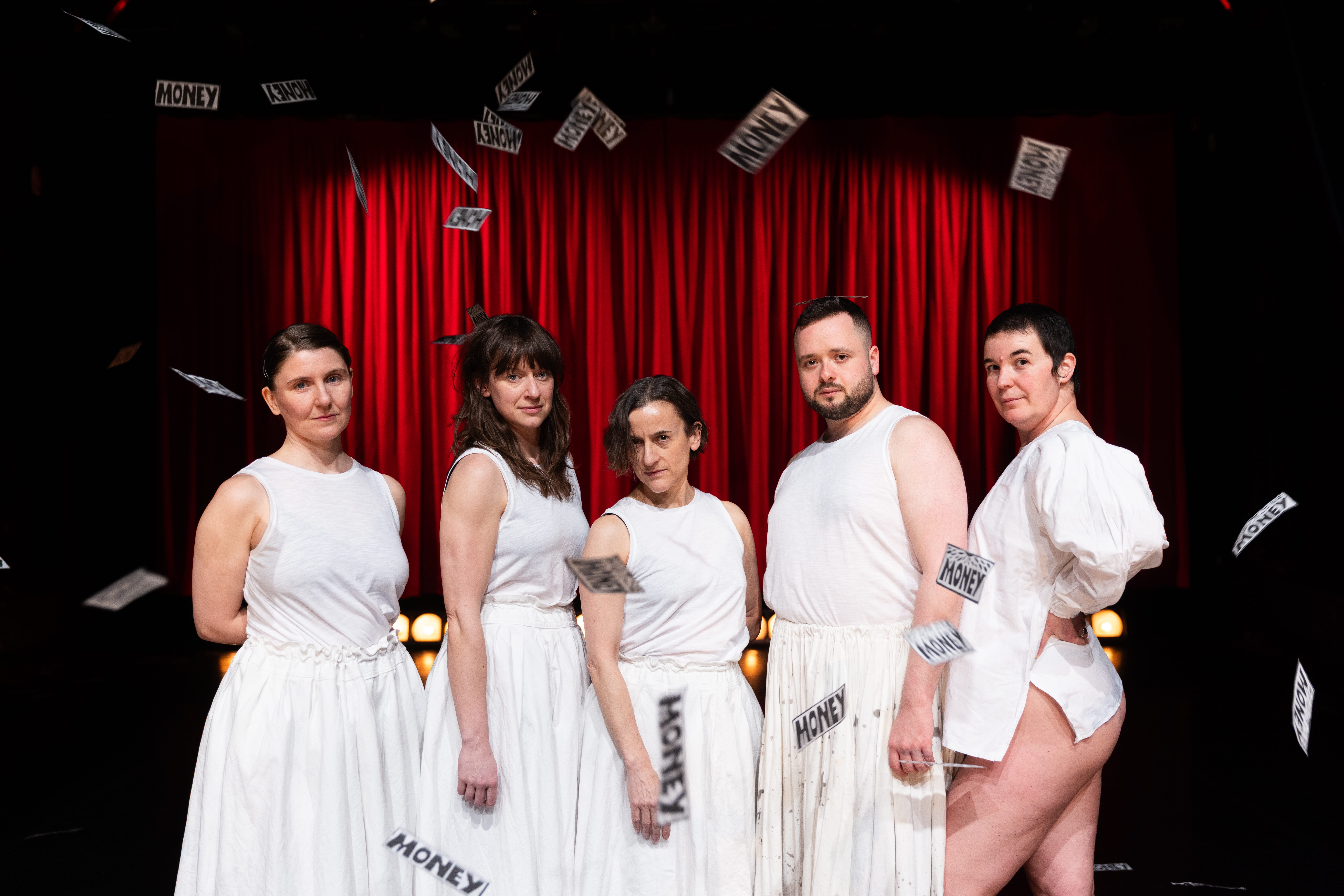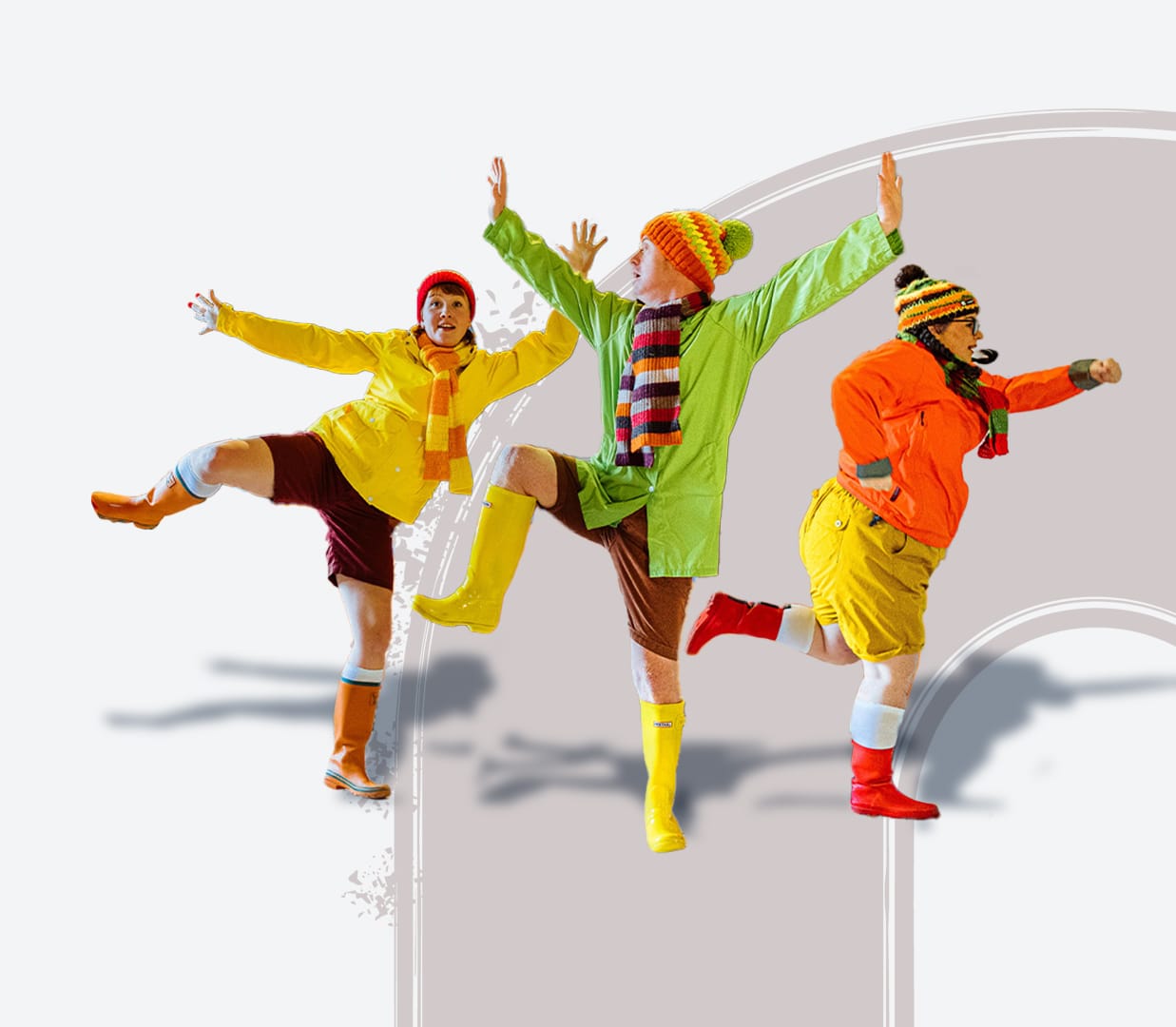Our talented group of Young Critics have recently reviewed Two Destination Language's production of Bottoms.
Young Critics are an imaginative collective of students that value collaboration and innovation. Together, they review and help shape future theatre programming.
Reviews
At a moment when the world outside seems to burn, flood, and fracture, Bottoms, the latest work from the award-winning company Two Destination Language offers both an escape and an indictment. Presented at Lakeside Arts as part of the NottDance Festival, Bottoms takes the 19th-century can-can as its historical and choreographic touchstone, transforming its exuberant kicks and frills into a complex meditation on value, labour, and the survival of creativity under capitalism.
Choreographed by Katherina Radeva and dramaturged by Alister Lownie, the piece unfolds in a lush landscape of velvet drapes and Victorian underskirts, invoking the cabaret while simultaneously unravelling it. Five dancers: Sita Pieraccini, Chloe Sayers, Tess Letham, Jennifer Irons, and Radeva herself embody a rare combination of mischief, ferocity, and tenderness. Unlike the homogenised bodies often seen in contemporary dance, this ensemble of middle-aged women with diverse body shapes reclaims the can-can’s historical unruliness. Their movement becomes not an aesthetic spectacle for consumption but a collective assertion of presence of bodies that work, age, sweat, and endure.
The choreography riffs on the can-can’s origins among industrial labourers who once danced to reclaim joy from exhaustion. Here, that exuberance becomes a form of protest. Between sequences of tightly coiled energy and moments of collapse, the performers oscillate between abandon and restraint, joy and fatigue mirroring the cycles of production and depletion that structure our modern lives. This dialectic is most strikingly embodied in a sequence where the dancers strike near burlesque poses as money rains upon them, only to gather and “clean” the notes in a slow, deliberate ritual. The gesture crystallises the show’s sharpest question: what is the cost of making art in a world where even pleasure is commodified?
Sound and light play crucial roles in sustaining the work’s atmosphere of precarious festivity. Michael Picknett’s score fuses industrial hums with fragments of cabaret melody, while Marty Langthorne’s lighting alternates between the glare of the factory floor and the shimmer of the music hall. The effect is at once nostalgic and unsettling an evocation of glamour tainted by grit.
The performance concludes with an impromptu art auction, in which Radeva’s three black Indian ink paintings (created live during the show) are sold to members of the audience. What might have seemed a playful postscript becomes, instead, a quietly devastating commentary on art’s commodification. As spectators bid for the wet, inky relics of performance, the exchange literalises the question the piece has been circling all along: how do we measure the worth of art or of labour when survival itself is on the line?
Bottoms is both joyous and defiant, raucous and reflective. It honours the can-can’s anarchic spirit while turning its history inside out, asking how we might still dance wildly, foolishly, beautifully in the ruins of late capitalism.
Combining dance, comedy, fine art, and theatre, Two Destination Language’s Bottoms defies genre and expectation, creating something radically original and unapologetically quirky. Bottoms is a riot: riotously fun, but also an act of insurgence that raises sharp questions about sexuality, labour, and the value of art.
This modern reimagining of the can-can subverts contemporary expectations of this iconic dance, transforming it into something bold, defiant, and compelling and ultimately returning it to its pre-commercialised roots. At one point, the talented performer Sita Iona Peraccino begins to sing Offenbach’s synonymous melody, gradually incorporating panting, moaning, and high-pitched shrieking. It is transformed into something simultaneously eerie and absurd yet hilarious and deeply erotic. The scene lasted for an uncomfortably long time, seeming to intentionally prevent us any reprieve and turn us into a voyeur. This was later enhanced when the dancers walked backwards towards the audience, their skirts covering their bent over upper-bodies, revealing their bottoms in a comically drawn out shuffle. These tongue-in-cheek, caricaturist moments, seem to ask us to ponder the roots of the dance as it evolved from a wildly liberating and fun pass time for the working class to a highly commercialised, exploitation of sensuality tied with prostitution and homogenized beauty. In this witty defiance of the male gaze, it also seems to reclaim it as a wildly empowering assertion of sexuality unfettered by the external gaze. It becomes a symbol of sheer unadulterated enjoyment of our physicality, raw and very real.
Other themes emerge throughout, especially around labour and the value of art. Where traditional dance strives to make moments of strenuous, expert athleticism look effortless, Bottoms deliberately exposes it. It gives us a peak of what goes on behind the curtain, making us confront the sweat, the ceaseless pounding of feet you can hear over the music and their slumping from exhaustion. The performance refuses illusion, showing the cost of performance itself. It’s a rare and strangely moving experience to see dancers not as ethereal entertainers, but as workers. I have never experienced such
frankness within a piece before, it is both confusing initially but utterly absorbing. It also points to the exhaustion of labour across all fields, the monotony, the weariness yet the inability to stop.
Throughout the performance, Katherina Radeva among the scenes on stage, created these stunning live indian ink drawings of can-can dancers. The dance portion then finished and it moved onto a theatrical scene that engaged directly with the audience. This portion seemed to ask us to confront the value we place on art; how our valuations are influenced by elitism within the art industry and how we have become accustomed to consuming art without having to pay a living wage to those who produce it. However, I do wonder how implicit some of themes of labour and value were, without being told the major themes beforehand. However, isn’t this the mark of art, to leave room for interpretation, to cause confusion and spark questions? I think this is perhaps what made it so engaging, it didn’t lay out its themes explicitly, it asked you to think on them, even well after the piece had finished.
Bottoms refuses to obey conventions and in doing so asks you to question theirexistence. It is chaotic, intelligent, and gloriously eccentric.
It was an exciting and immersive experience to watch Bottoms as part of FABRIC’s NottDance festival at Lakeside Arts. Created by award-winning artists Alistair Lownie and Katherina Radeva from Two Destination Language, the performance was very different from any other kind of dance performance I’ve seen before. It was thought provoking, humorous, undeniably quirky, and certainly ‘outside of the box’.
Katharina prides herself on her art not fitting into boxes that society makes for us, and both herself and Alistair showcased their drive to experiment with what art is and what it means to audiences in this performance. The type of performance itself didn’t fit into the expected box of what a dance performance traditionally looks like; it didn’t feel like a story was told with a traditional plot or narrative structure. Instead, with the performance being interdisciplinary with its art forms, it allowed for the deeper exploration of certain themes. It was fascinating to have my attention divided between unique music and sounds – or ‘sound world’ as Katharina and Alistair called it – the dancers performing different can-can inspired dance motifs across the stage, and Katharina illustrating gorgeous mannequin-esque dancers on huge ‘80cm x 120cm’ canvases. Coupled with audience interaction for the ‘Art Sale’ at the end, the different forms of art and performance made a really unique viewer experience, and each art form was able to introduce a new concept for the audience to question their response to.
Rather than leaving the theatre thinking about the journey the dancers took as characters on the stage, I left questioning my own interpretation and understanding of what dance is, and how I value a performance. In a post-show conversation with Katharina and Alistair, I was prompted to ask a question about the relationship between sex (both biological and intimate), gender, performance, and capitalism in their show. It was a weighted question, but summed up some of the key talking points that I understood from the performance; how we perform our identities based on hegemonic ideas of gender, and how capitalist societies can twist identity performance for profit (or lack thereof). It seems that we cannot separate sex, gender, consumerism, and performance, or how society categorises us in boxes based on our opinions and interactions with these things. To me, it felt like the performance existed in conversation with this.
The performance was conceptualised around the can-can, a dance associated with very specific iconography and music, which in itself Katharina asks us to question. Why do we immediately think of slim women adorned with their big skirts, slender legs, and high kicks? Why is the image we picture charged with gendered ideology, sexualisation, and spectacle? The history of the can-can boils down to a form of protest and riot against a suffocating lack of expression in 19th century society, which is revisited here, where the can-can helped Alistair and Katharina to form a social commentary on the value of art and its place in society, specifically that that is created by women, and a critique on the idea that ‘sex sells’. The performance breaks down hegemonic boxes for society’s understanding and experience of gender, performance, and sex, and how they link together. It celebrated the human body in different forms, and foregrounded art created by women, epitomised when Katharina’s beautiful Indian ink drawings were sold at the auction at the end of the show.
Bottoms opens up a conversation about value: how we value art (and labour), how we value women, and what ‘performance’ means to us in society. I am not sure that I have been able to fully communicate the nuance and complexity of the conversation, but it was an honour to get to explore the tip of this iceberg with Katharina herself, and I thank Lakeside Arts, FABRIC, and Two Dimension Language for the ability to be part of the conversation.
Five performers entered from stage left, backed by a red velvet curtain and footlights that shimmered on their gold and silver skirts, while one built from a hum to a belt a rousing rendition of the Can-Can song. Once this performance and the laughter it caused had ceased, the traditional version of the same song resounded through the theatre, and the dance begun. As they flounced across the stage, skirts swishing, almost haunting smiles ornamented the dancers’ faces. At the can-can’s close, they stood in a row panting audibly and exhaustedly, said smiles resolutely still in place, giving the audience a true glimpse into the effort and potential pain of performance, a theme that was to run throughout the entire show.
From their line broke first one dancer, then another, dropping their poses to stand a little upstage, out of the spotlight, and crack open a can to revive themselves. Finishing her drink, Katherina Radeva – who leads, alongside Alister Lownie, Two Destination Language – began to paint five identical dancers on an easel at the edge of the stage. This interweaving of different art forms is a recurrent technique in the work of Two Destination Language, who pride themselves on their interdisciplinary approach to art and performance. Throughout the play, two more original works of art were painted before the audience, again emphasising the show’s central ideas of art as performance and a product of consumption. A more heavy-handed example of the necessary monetisation of art was a scene in which some rather Brechtian bits of card labelled very distinctly in bold, black letters ‘MONEY’, were swept around the stage by two of the performers, while the remaining three posed and preened provocatively, an uncomfortably real depiction of the commodification of women’s bodies over their talents that is all too prevalent in the various arts industries.
This comment was further exacerbated towards the end of the show – or what at first seemed the end of the show, to an audience about to be drawn unexpectedly into it – when the performers all changed from their typical dance costumes into everyday wear in a very humanising way. In the post-show discussion, Radeva and Lownie explained their intentions of reclaiming the can-can from the restrictive norm of women whose appearances must tick all sorts of boxes to perform it. In the casting of actors who did not fit such a rigid cliché of what a dancer should look like, and in this scene so clearly emphasising that, Bottoms paid homage to the revolutionary and counter-cultural origins of the can-can, and loudly conveyed the message that art is for everyone.
In the greatest surprise of the night, a genuine art auction was held for the paintings that Radeva had created throughout, with the final one (featuring, shockingly, bottoms) selling for a total of £85. This concluding sale took yet further the show’s messages about the value of art, and the worth of creation to both the creative and the consumer in such a way that left the audience both laughing and deep in thought.
Torn between frenzy and freedom, Two Destination Language’s dance production Bottoms explores the value of art and the price of labour. This modern twist on the French Can-can highlights the tension between artistic expression and commercialisation, raising more questions than it answers.
Question 1: Why the Can-can?
Bottoms reimagines the Can-can: a French cabaret dance from the 19th century. Although now associated with chorus girls and the ‘Moulin Rouge’, in the post-show discussion, Katherina Radeva explained the dance’s roots in working-class, male riot. This fascinated me: the dance’s commercialisation into a theatre-dinner package makes it an ideal feminist vessel.
Can-can dancers were often prostitutes, as vividly realised in one sequence in ‘Bottoms’, and this sexualisation subtly pervades to the present-day setting. One performer turns around and slowly, slowly pulls on a ‘Juicy’ tracksuit. The clothes and era may be different, but the price of female art stays the same.
In the post-show discussion, Alister Lownie explained his interest in ‘offering the Can-can without fully doing it’. By challenging dancer stereotypes, the show questions dance traditions of favouring technique and training (a.k.a class identity) and body type and youth (a.k.a femininity).
Another interesting theme was the influence of art and observation. This is two-fold: the audience observes Radeva observe the dancers as she live draws them onstage, akin to famous Can-can painter Henri de Toulouse-Lautrec. Certain performances of Bottoms seem to have a male-presenting dancer onstage too, which would have further explored gender roles and voyeurism.
Question 2: What was the show’s social message?
The show’s title, Bottoms speaks not only to the objectification of Can-can dancers, but also to their low position in the social hierarchy. This is a socialist performance as much as a feminist one.
During frenzied sequences where dancers leapt across the stage, riding horses in the age of Napolean to the ‘William Tell’ overture, the audience were charged with an absolute joy of life. However, this choreography would be repeated, making audiences question the authenticity of this joie de vivre. Is our happiness just another product in a capitalist society? Is it enough to make art, or should this labour be packaged and promoted?
Rather than simply ask these questions, Bottoms physically enacted them…
Question 3: Why was there an art auction in the show?
Reflecting the different backgrounds of Radeva and Lownie, Bottoms intersected live drawing, music, theatre and dance. You could hear the performers’ laboured breathing, emphasising their hard work.
Hard work was also reiterated by Radeva during the mid-performance art auction, where she sold the live drawings made in the performance. She herself became a product in the third person, with tongue-in-cheek references to the art selling better after her death.
But Radeva equally highlighted how art by female Bulgarians value for less and the audience aren’t sure whether to laugh… especially once the card machine come out and it becomes clear that this a real auction.
I really respected the performers putting these artistic questions into practice, and highlighting the volatile nature of freelance theatre. You may empathise with modern and historical artistic labour – but are you willing to reach into your wallet for it?
Question 4: So why should I go and see Bottoms?
For me, Bottoms was a challenging, truly thought-provoking artwork. Without the post-show discussion to contextualise the performance, I would have missed a lot of the historical themes – although the performers’ energy is engaging enough without the context.
By being difficult to categorise, is Bottoms defying the ease of commercialisation? This is a show that takes effort to understand but, as Radeva highlights throughout, the price of labour is often worth it.
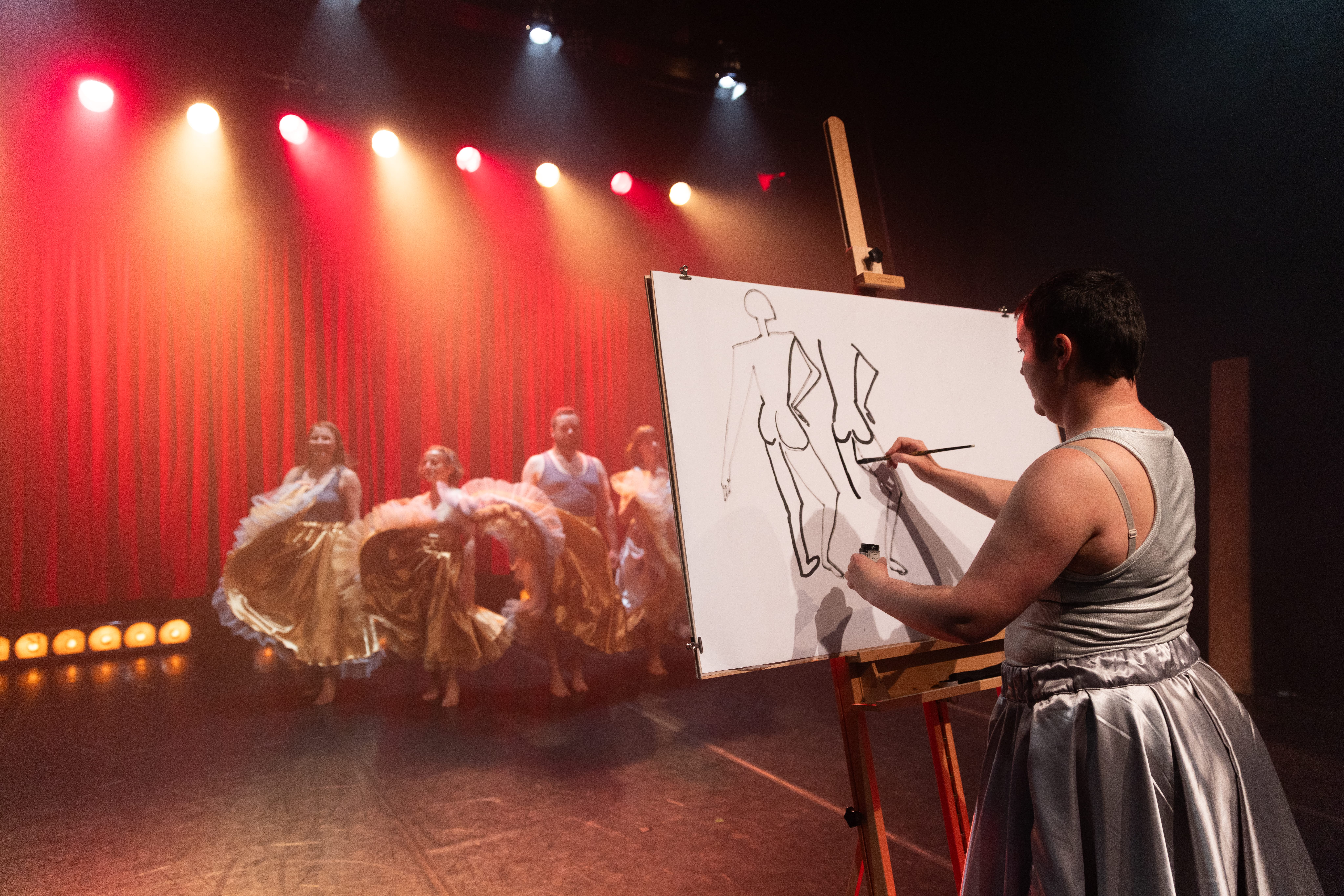

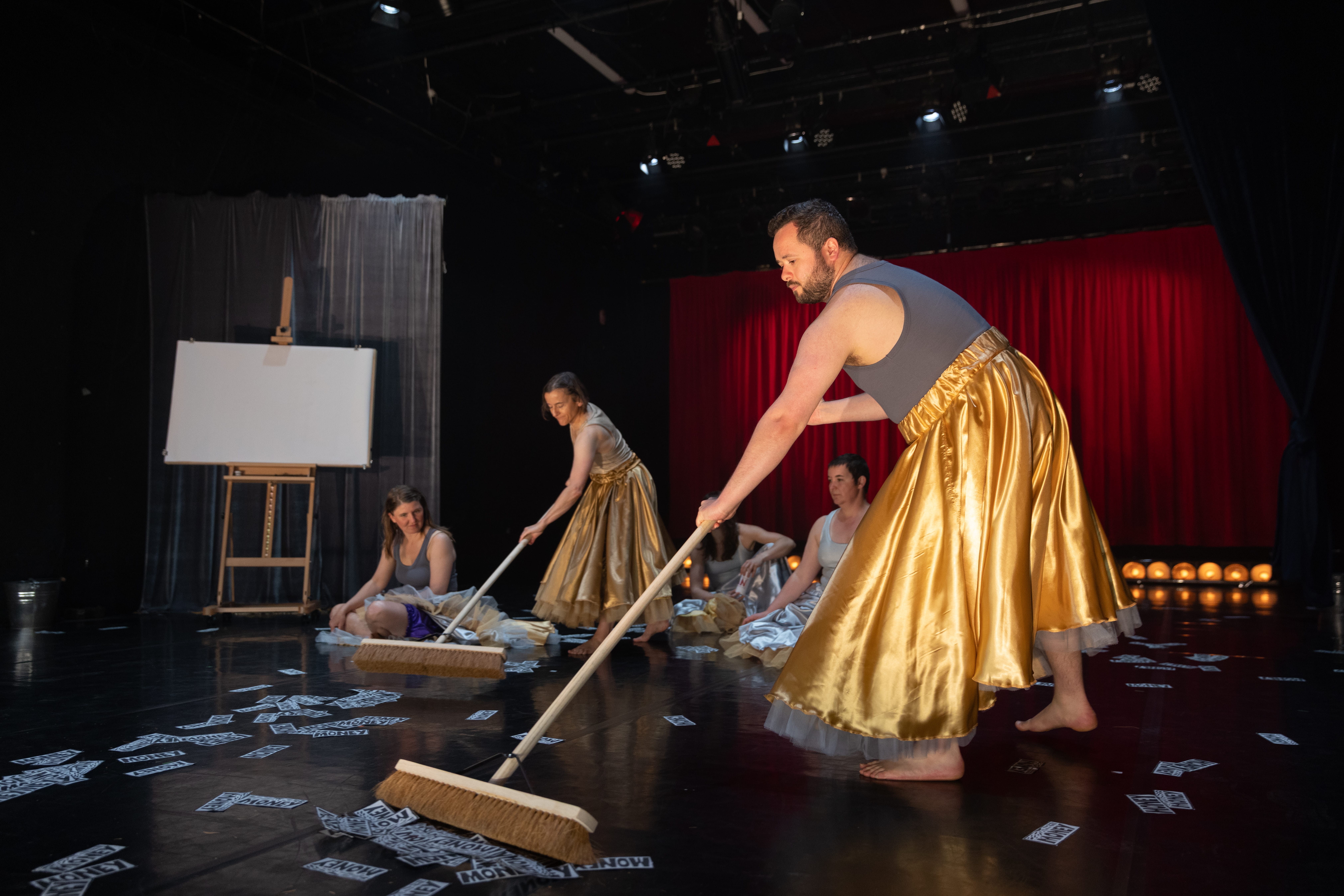

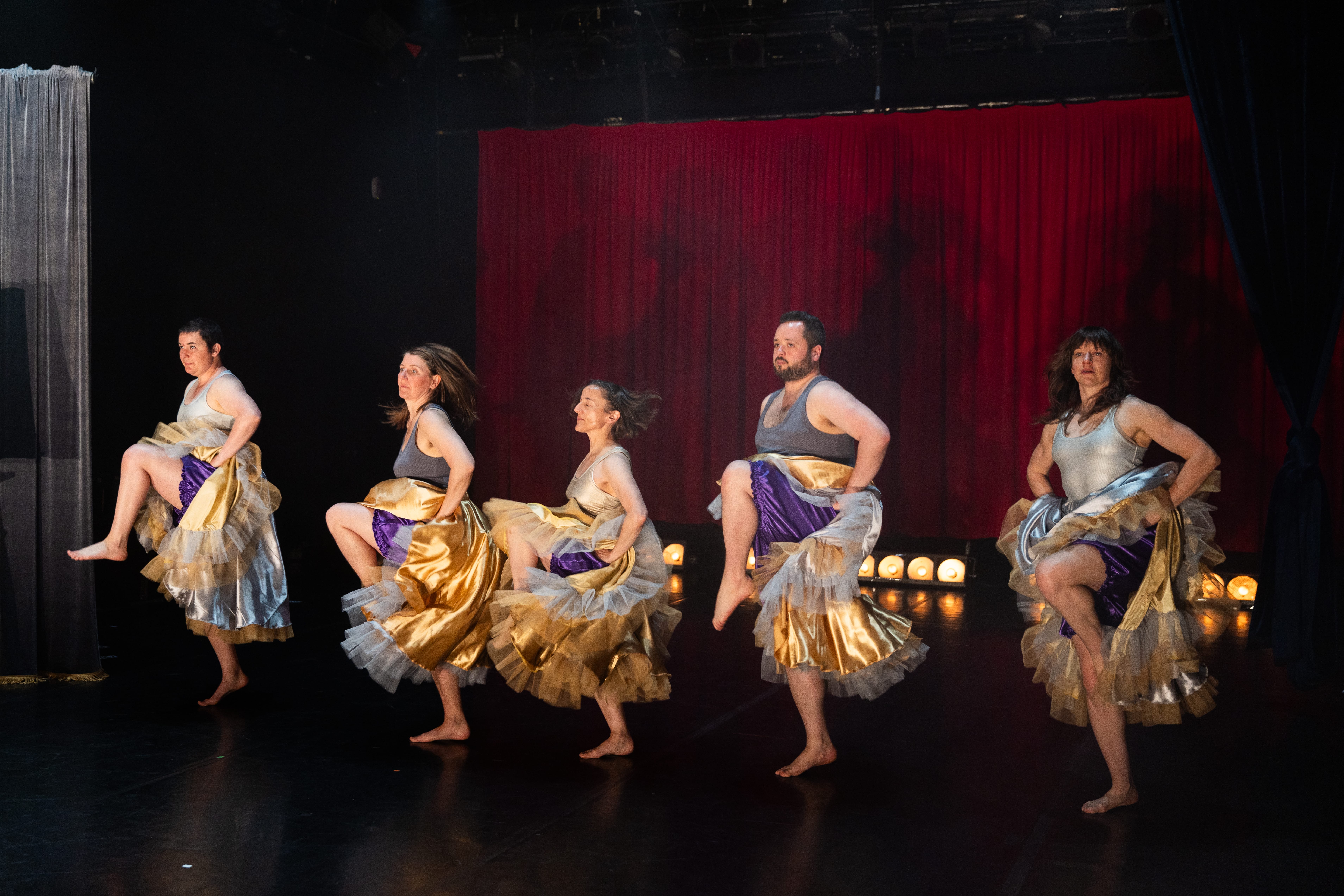

Read more from our Young Critics here:
Review


Wed 18 Jun 2025
Young Critics Collective: Penguin by Hamzeh Al Hussien
Young Critic Cerys offers an insightful review of Penguin by Hamzeh Al Hussien, a performance centred on community and identity.
Review


Mon 3 Mar 2025
Young Critics Collective: The Animator
Our talented group of Young Critics have recently reviewed the Akimbo Theatre Company production of The Animator. Stepping into the captivating world of Lotte Reiniger, the visionary who created the very first feature-length animation film, our seven Young critics give their opinions on this dynamic performance.
Review
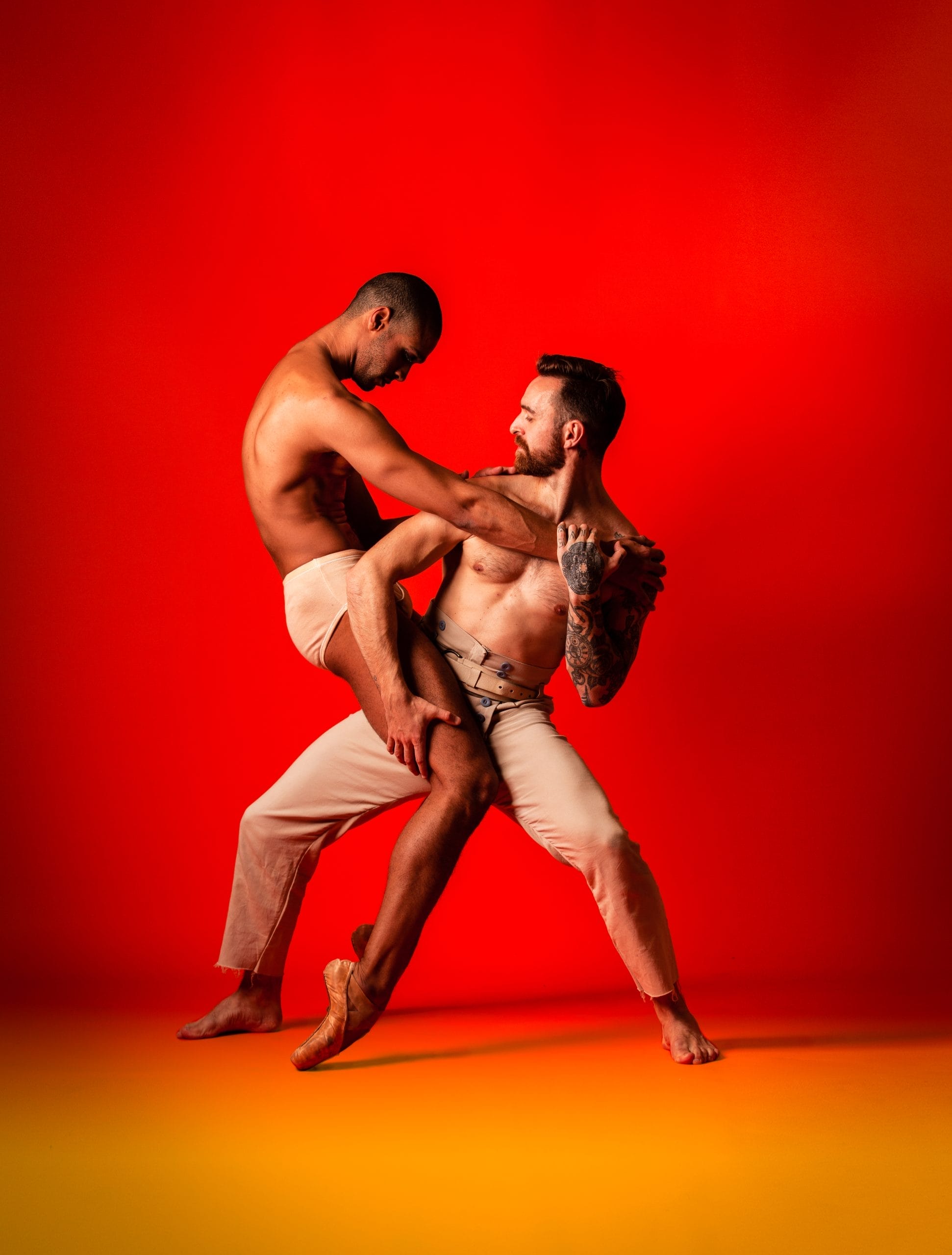

Tue 3 Dec 2024
Young Critics Collective: Mariposa
Our Young Critics have recently reviewed DeNada Dance's show Mariposa, a queer tragedy inspired by Puccini's Madame Butterfly.
Review
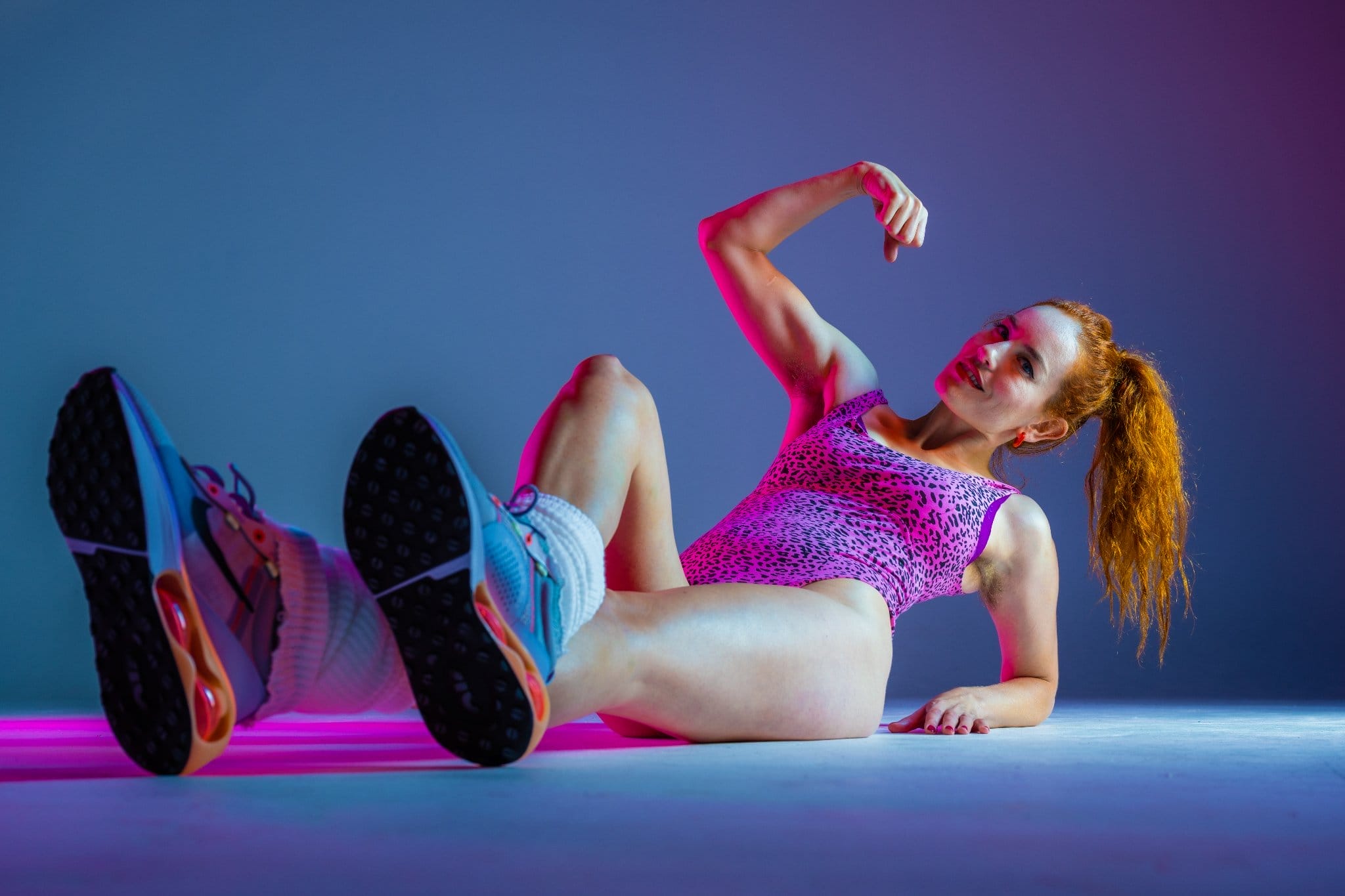

Wed 12 Feb 2025
Young Critics Collective: Rosy Carrick Musclebound
Our Young Critics have recently reviewed Rosy Carrick's Musclebound; One woman’s quest for freedom, pleasure and real sexual power. Their feedback was received on Wednesday 12th of Feb 2025.
Review


Sun 10 Nov 2024
Young Critics Collective: Pinocchio
Our Young Critics have recently reviewed Stuff and Nonsense Theatre Company's Pinocchio. Their feedback was given on Sunday the 10th of November 2024.
Review


Tue 29 Oct 2024
Young Critics Collective: Make Good: The Post Office Scandal
Our Young Critics have recently reviewed Lakeside Arts, Make Good: The Post Office Scandal. Their feedback was given on Tuesday 29th of October 2024.
Review


Wed 18 Jun 2025
Young Critics Collective: Penguin by Hamzeh Al Hussien
Young Critic Cerys offers an insightful review of Penguin by Hamzeh Al Hussien, a performance centred on community and identity.
Review


Mon 3 Mar 2025
Young Critics Collective: The Animator
Our talented group of Young Critics have recently reviewed the Akimbo Theatre Company production of The Animator. Stepping into the captivating world of Lotte Reiniger, the visionary who created the very first feature-length animation film, our seven Young critics give their opinions on this dynamic performance.
Review


Tue 3 Dec 2024
Young Critics Collective: Mariposa
Our Young Critics have recently reviewed DeNada Dance's show Mariposa, a queer tragedy inspired by Puccini's Madame Butterfly.
Review


Wed 12 Feb 2025
Young Critics Collective: Rosy Carrick Musclebound
Our Young Critics have recently reviewed Rosy Carrick's Musclebound; One woman’s quest for freedom, pleasure and real sexual power. Their feedback was received on Wednesday 12th of Feb 2025.
Review


Sun 10 Nov 2024
Young Critics Collective: Pinocchio
Our Young Critics have recently reviewed Stuff and Nonsense Theatre Company's Pinocchio. Their feedback was given on Sunday the 10th of November 2024.
Review


Tue 29 Oct 2024
Young Critics Collective: Make Good: The Post Office Scandal
Our Young Critics have recently reviewed Lakeside Arts, Make Good: The Post Office Scandal. Their feedback was given on Tuesday 29th of October 2024.













